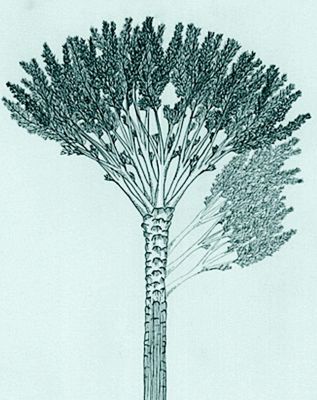Journal of Creation 28(2):15–16, August 2014
Browse our latest digital issue Subscribe
‘Earliest’ fossil ‘forest’ surprisingly complex

There are many reports of fossil ‘forests’ across the earth that display vertical tree remnants.1 Vertical tree stumps and trunks are assumed to be in situ, which seems to be the definition of a fossil forest. Evolutionists think that the first forests would have been simple and composed of a single type of tree:
“Think for a minute about ‘early’ life on land. Complexity is probably not the first thought that springs to mind.Botanists also tended to consider the earliest forests to be simple entities composed of a single type of tree.”2
This was reinforced by the discovery in the 1920s of the ‘earliest’ fossil ‘forest’ in Gilboa, New York, that was believed to be composed of just one type of tree that grew in a swamp.
Spectacular sandstone casts formed by fossilized stumps of hollow tree ferns over 6 m (19 ft) tall with slender trunks had been excavated. They resembled modern palms or tree ferns.
Two more trees discovered
New mapping within the quarry at Gilboa over an area of 1,200 m2 has revealed two more types of trees. Suddenly this earliest forest, dated Middle Devonian (about 390 Ma in the evolutionary timescale), became surprisingly more complex.3
One of the new plants is a woody root some 4 m (13 ft) long and up to 15 cm (6 inches) thick that is believed to have grown underground and sprouted a few metres above ground (figure 1). The third is a rare lycopsid-like tree. Lycopods, similar to club mosses, are the main type of trees making up the Carboniferous coals.4
The trees are claimed to have been found in a ‘paleosol’, a darkgrey sandy mudstone. A total of 486 densely packed ‘objects’ were counted in the paleosol surface including root mounds, horizontal stems, and aerial plant fragments. Some trees are interpreted to be in ‘growth position’.
This discovery has required a much more sophisticated explanatory ecology because the three types of plants apparently had wide differences in growth habits, abundance, and supposed evolutionary relationships. This result demonstrates that other supposedly early terrestrial ecosystems are similarly complex.
Once again, additional investigation has shown that simplistic evolutionary concepts are not only inadequate, but the revealed complexity is better explained by Creation and the Flood.
It is also likely that in the absence of plant remains, the Gilboa stratum would not have been identified as a paleosol.
Ecological questions
In the eyes of uniformitarian scientists, the ecology of this early forest has suddenly become much more complex. The simple assumption of one type of tree for one location has been overturned:
“The structure of Devonian landscapes [composed of just one type of recently evolved tree] has almost become a dogma in palaeobotany, but Stein and colleagues’ report provides the first direct evidence that some early forests contained widely divergent groups of plants.”5
The three types of plants have eliminated the simple swamp idea. Now, it is believed that the trees grew ‘near the shoreline of an inland sea’.5
The reason for this particular paleoenvironment is because it is believed “that the forest was periodically affected by brutal episodes of sea-level rise, which killed some of its plant life”.6
In other words, the trees were affected “ … by recurrent, marine-influenced and possibly catastrophic processes with a relatively high frequency of disturbance”.7 This idea was suggested by low-angle cross-bedded sandstones in the same strata elsewhere in the region. These types of cross-beds are formed in fast flowing water.8
In addition, the roots of one type of tree at the site contained wood, which challenges the idea that wood evolved as a simple adaptation to support the tree or by hydraulic constraints.9 Wood was there at the beginning within the evolutionary scheme, even in the roots.
Looking more like a Flood burial of complex created trees
Uniformitarian paleoenvironmental interpretations should not be accepted at face value.10 We may not always be aware of them as they can sometimes be subtle. Whereas the Gilboa environment was thought to be a simple ancient swamp, a better analysis with more data reveals the inadequacy of this interpretation.
The dense packing of the plants suggests this ‘forest’ is not a growth environment but a dumping ground for transported plants. In fact, the environmental interpretation is now invoking periodic catastrophic burial by fast flowing water, of trees in an ecologically complex environment. Although the interpretation is still tainted by uniformitarianism, it is getting closer to Flood burial of complex created trees.
References and notes
- Oard, M.J., The Genesis Flood and Floating Log Mats: Solving Geological Riddles, Creation Book Publishers ebook, 2014. Return to text
- Meyer-Berthaud, B., and Decombeix, A.-L., In the shade of the oldest forest, Nature 483(7387):41–42, 2012 | doi:10.1038/483041a. Return to text
- Stein, W.E., Berry, C.M., Hernick, L.V. and Mannolini, F., Surprisingly complex community discovered in the mid-Devonian fossil forest at Gilboa, Nature 483(7387):78–81, 2012 | doi:10.1038/nature10819. Return to text
- Woolley, J.F., The origin of the Carboniferous coal measures—part 1: lessons from history, J. Creation 24(3):76–81, 2010. Return to text
- Meyer-Berthaud and Decombeix, ref. 2, p. 41. Return to text
- Meyer-Berthaud and Decombeix, ref. 2, p. 42. Return to text
- Stein et al., ref. 3, p. 81. Return to text
- Austin, S.A., Interpreting strata of Grand Canyon; in: Austin, S.A. (Ed.), Grand Canyon: Monument to Catastrophe, Institute for Creation Research, Dallas, TX, p. 32, 1994. Return to text
- Gerrienne, P., Gensel, P.G., Strullu-Derrien, C., Lardeux, H., Steemans, P. and Prestianni, C., A simple type of wood in two early Devonian plants, Science 333(6044):837, 2011 | doi: 10.1126/science.1208882. Return to text
- Oard, M.J., Beware of paleoenvironmental deductions, J. Creation 13(2):13, 1999. Return to text






Readers’ comments
Comments are automatically closed 14 days after publication.